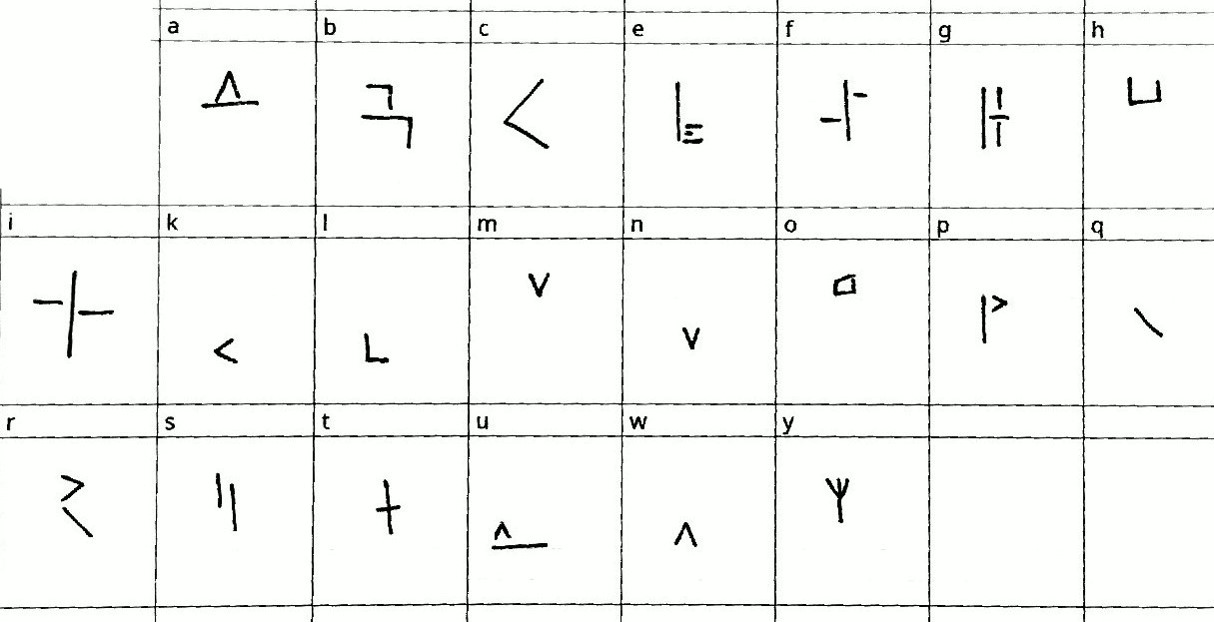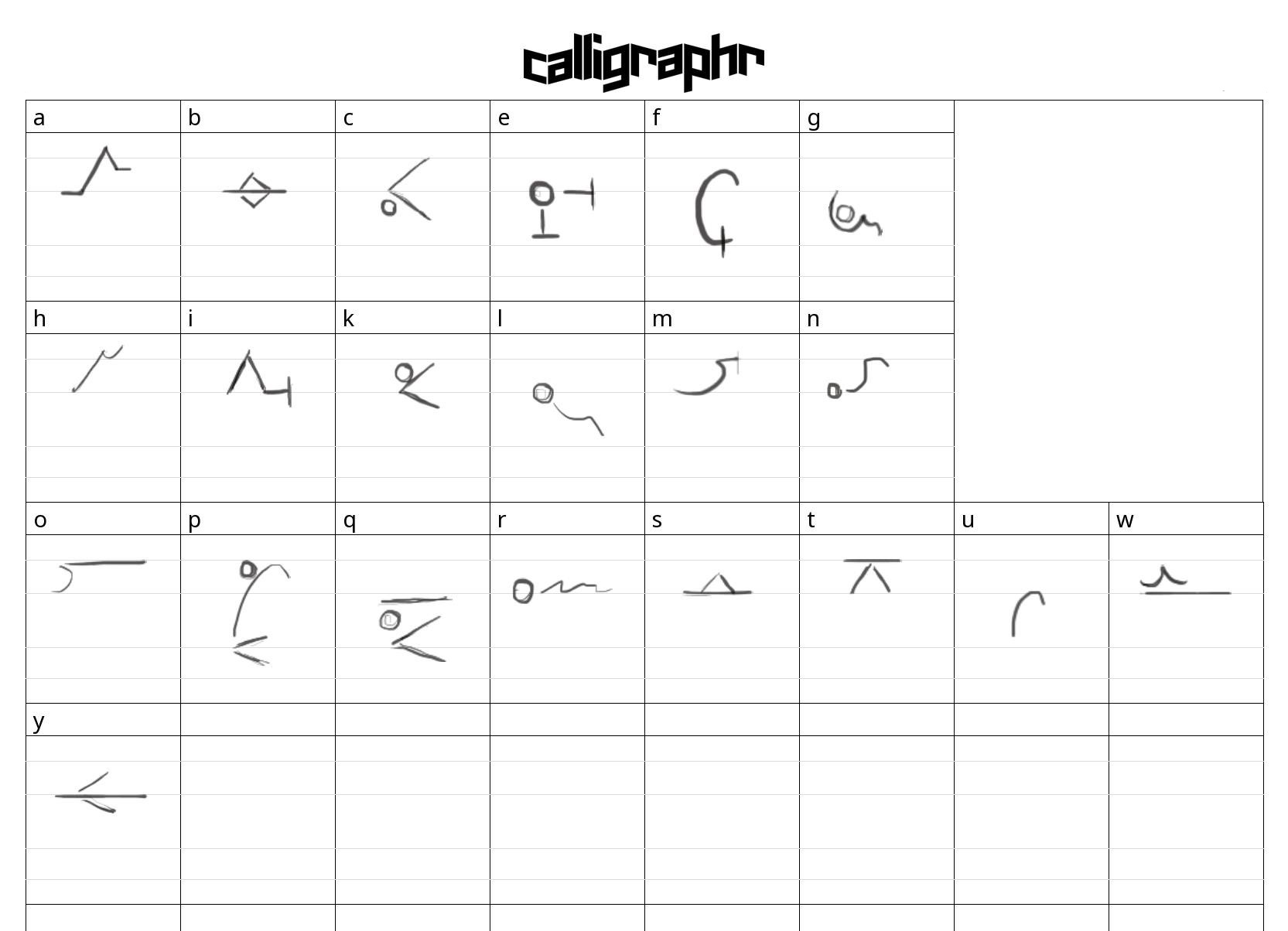Spoken by the Umatoe Clan primarily.
To the point, much like the clan speakers. A sentence is often expressed in a single word, so a conversation does not take long and messages can be sent clearly and effectively. There are several base words that came from the Atmu during the Age of Creation, but many of these root words have been lost or mangled to the point of no recognition as the language evolved.
Writing System
Alphabet was constructed via the Umatoe noting where the sounds came from and essentially creating a diagram around the face and making symbols to match how the sound felt; sharp sounds are represented by "<" and the higher or lower they are in the symbol represents if that sharp constricting came from the chest or the throat (in the case of C being "Khh", where "<" is higher than the origin, meaning the sharp burst of air comes from the mouth, versus K being "Khe" where "<" is lower than the origin, indicating the sharp burst of air comes from the chest/diaphragm). A circle indicates a soft-ish origin point. Lines appear in the letter to indicate the direction the sound took, either a spike to indicate a sharp incline/decline in the sound, a bar at the end to indicate an abrupt ending, or a straight line to show the sound's simplicity. Squiggles or soft lines indicate a soft or gentle reverberation (in the case of R being more like a rolling R)
Primarily the sounds are centered around sharp punches of the diaphragm and throat, sustained sounds from the mouth, lifting of the top lips and some nasal breaths.
Concept-driven: Main idea+qualifier+modifier combined. The main idea is always the first word used, and the following words used are reliant upon the new subject trying to be expressed. If only two words/concepts are being combined, only three symbols/syllables are used from each word, taking off a symbol/letter for each new word added. Many sentences wind up being expressed in a single word.
A - "Aa^hg" or "A^h", low in the throat
B - "Pp", breathy
C - "Khhuh", back of throat, rolling up towards the nose
E - "ae" or "eh", breathy
F - "Eph", breathy
G - "rrrr", a low rumble
H - "hiii", mouth partially closed, sharp breath between teeth
I - "Ih" or "I^gh", punchy
K - "Khe", harder than C sound, more in mouth than throat
L - "nnl", tounge on roof and mouth mostly closed
M - "Mmh", end has a bit of a punch
N - "Nn", slight roll through the nose
O - "Ow" or "Ahow", mouth moves around the sound
P - "Prhh", rolling between the cheeks
Q - "Khgh", almost like a cough
R - "Rrr", rolling, closer to back of throat or nose
S - "iihhh", prolonged breathy
T - "Teh", emphasis on the beginning
U - "Ur", no rolling, like a grunt
W - "owr", no rolling, like a bark
Y - "ee", punchy, not breathy
Generally they speak in complete present-tense. If there's no qualifiers for a statement, it's assumed to be in the present.
That said, the Umatoe have a way to speak in past and present:
Pa - means "After" but when used with a present-tense word, it's used to note something that happened in the past, ie "I told you" would be "Haaryć-pa"
Nekhem - By itself it simply means "Future", but when combined with a present-tense word it's usually shortened to just "Ne" it notes future-tense, either an "I will/I'm going to" statement or if someone is laying out steps or an outline, ie "This thing and next this thing", the first thing would be present-tense, and the next step would be stated as present-tense but would have "ne" on the end to note that it comes next/in the future from this moment
Everything, from individual word to sentence is based on "main idea-qualifier-modifier", then using the first two or three symbols in each to create a new symbol with a new definition.
Unless ‘living’ was more a term like ‘snow-blood’ which would be SnehemIotreka or rather Iotreka+Snehem which would then become Io’Hem or Iohem (Blood of Snow) in which the term ‘blood’ would be used to identify relations and I like that better so HA but it likely would still be affixed to something alive that or the opposite (death) would be something like ‘Nie’ affixed to the end, so IohemNie would be death, and I do think ‘living’ would be attached to something that they want it to be known that it’s living, especially when it is not supposed to be living, in which case something like ‘living ice’ would be Lo’Iohem.) Likewise, “Living Trick” or one who seems to be a trickster incarnate would be labled Niek’nia’Iohem (Or, to shorten it if they wanted to later on, would be something like Niniioh, lol)
So names are different than conjunctive words
While names are also simply conjunctive words, they are put together simply, with no indicators as to where words begin or end for the sake of simplicity and to show that the name isn’t a connection of words so much as it is the Saber’s concept of self or the communities concept of the individual.
The rest of the words are subject-conjunctive-dependent, which essentially is that the words are the combined word’s main subject connected through the ‘ symbol, and are dependent what what the subject is; so the way to make a new word in Chuff is to take the main idea of the words, arrange them in the order of “Main Idea+Main Idea” or “Main Idea+Qualifier” or “Main Idea+Modifier” or a combination of all, where the main idea is always the first word used, and the following words used are reliant upon the new subject trying to be expressed. Then, if the words are longer then three letters, you cut them off after 3, i.e “Iohem” is “Iotreka” and “Snehem” where ‘treka’ was taken off, and ‘sne’ was likewise removed to create a new word.
The use of the symbol ‘ depends on the time the word was created, as was the length rule, as some family groups that named places or things refused to shorten the words in the belief that the meaning of the words would lose their power and meaning if they were shortened or changed in any way, while some other groups thought that the cutting of words helped others to understand and speak, spreading information among the others and therefore allowing access for other clans and other groups to understand. However, the structure was fairly widespread and popularly used.
When written, a small mark can be seen between two letters, something similar to the ' symbol. This means there's repeated letter immediately next to the one proceeding it, and when spoken the repeated sound is often left out.
Original Symbols used during the age of creation
Evolution of the language, developed after The War State
Common Phrases
Hreiostmei
Warmth-Among, A greeting
Sanum
Use resources to best ability
Utenut
"Uma is as Uma does" or "Uma will be Uma", Meaning something along the lines of “We may all be different, but we are all the same as well” - it is often a guiding principal, one that states differences are not enough to permanently divide them; there are some things that are the same across the board, no matter which regional clan you come from, it’s a statement of community and sameness while acknowledging diversity and mindsets
Lobi
Became known as “Ice-White” and became a word for something inherently non-trustworthy, as ice that is opaque looks solid but is often incredibly thin in Umatoe areas, cracking under little weight but sealing back up quickly to create a deadly situation. Essentially it became a word for ‘dangerously non-seethrough’, and the Umatoe that made it famous was dubbed “Lobiio”, literally ‘deceit that is alive’.





Comments